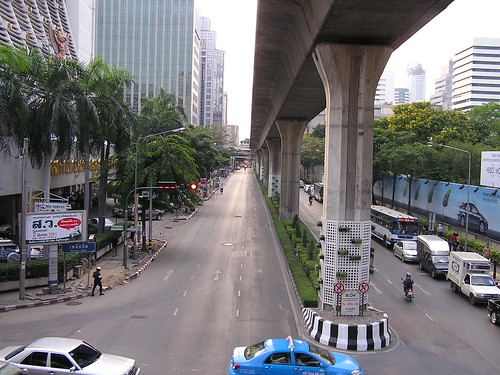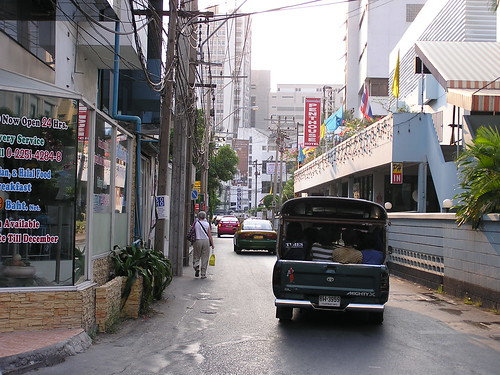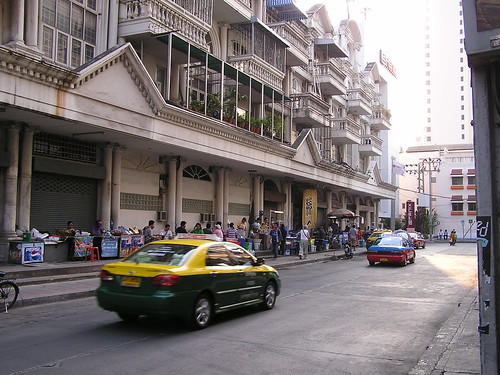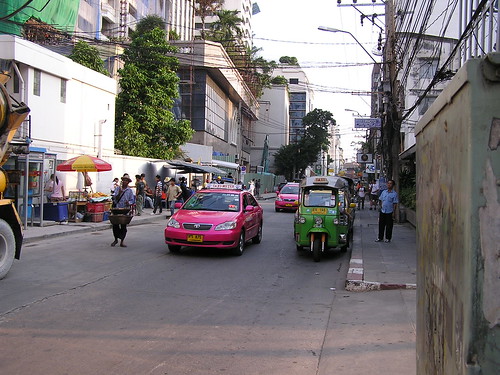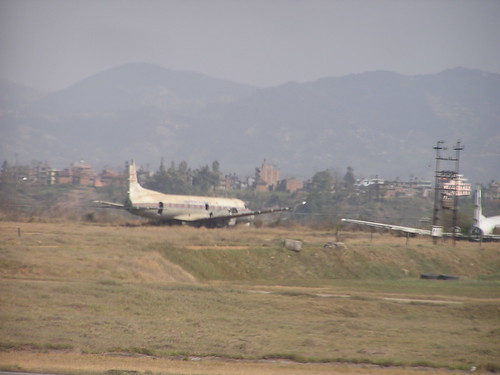
My first impression of Kathmandu was definitely that of a third world country. We came in through a haze of smog, and then the city sprawled out beneath us. We disembarked directly onto the tarmac and then were ushered inside. Immigration was quick and simple, without much fuss, and outside there were throngs of people. The weather was nice, however--hot, but dry. Dry is good.

Driving is hair-raising, to say the least. Lanes are more like guidelines, if they are indicated at all. If you are going to turn right (they drive on the left), then you first get into the right lane--with on-coming traffic!--and then turn right. Sometimes people will do this 50 yards or more ahead of where they are turning, and the people in the right hand lane are expected to get into the left lane to go around them. It is absolutely crazy! Our driver was also passing motorcycles--not sure I want to know how fast he was going in these winding streets. Pedestrians are just as likely to be on the road as on the sidewalk (if there is one). Same goes for motorcycles.

Horns are also used often. Even though all of traffic is obviously gridlocked, drivers will honk their horns mercilessly in a futile attempt to move traffic. These same drives will then stop in the middle of the lane and let people out to do shopping, waving traffic to go around. Apparently if you stop on the left side of the road and turn on your right blinker, it is to tell others to go around you. If you stop in the middle of the lane and turn in on, you are signaling a right turn. If the lane isn't wide enough to tell, the driver behind you decides what he thinks you are doing and acts accordingly.
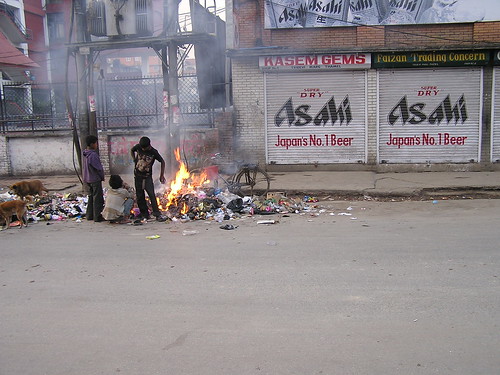
Sanitation seems almost non-existent. Trash is often removed from the street by sweeping it into piles and setting it on fire. This can be done right next to a house or other structure, in some instances. Men will relieve themselves on the street, and the two toilets I had to experience did not have toilet paper (one I didn't use, the other I had an alternative). There is a reason in many Indian and Islamic cultures one does not eat with the left hand.

Meat is kept fresh by keeping it alive. I saw many butchers starting in the morning--most of them preparing goats or boars. The meat was freshly cut and then just lying on a table--in one instance it had been thrown on the seat of a taxi for transport. I also noticed a house that had a small 'pit' made apparently for the meat, so the blood wouldn't drain everywhere. The folks hacking up the boar meat were particularly interesting--they left on some of the bristles, especially the mane, and otherwise coated the carcasses in an orange preservative of some kind--it may have been iodine or something similar. They cut them up as-is and sold them right there. Once an animal is slaughtered, the meat may sit out for the day. Though I did not see it, I am fairly certain as much as possible of the animal is used.
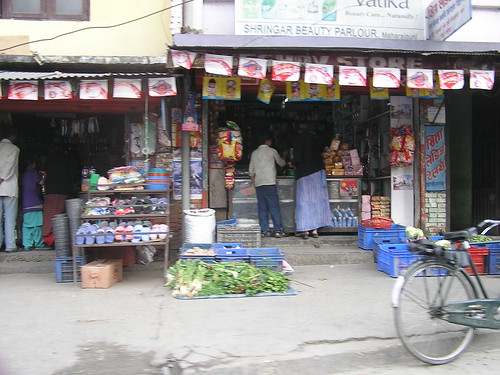
Vegetables are also sold on the street, with cars, bikes, and pedestrians kicking up dust all around. I've heard that food preparation can be a lengthy process of washing the food, soaking it in an iodine solution for 20 minutes, then washing off all of the iodine. And you still probably want to cook most of your vegetables just to be sure. That said, there are restaurants in Kathmandu that can be quite tasty.


This was Anatolia, a Turkish themed Indian and Tibetan restaurant. It was awesome! Some friends and I had chicken biryani, mutton rogan josh, panak paneer, chicken tika, and mutton shish kabob. We ordered regular, garlic, and butter naan. We finished it all off with Nepali (masala) tea. It was excellent. The Nepali tea here is almost like the Butter Tea we had at the Bhutan booth at the Diplomatic fair (where we met the Bhutanese princess that Ellen still hasn't elaborated on).
I have to admit, most nights we ate at our hotel, the Radisson, at the Olive Bar and Bistro:
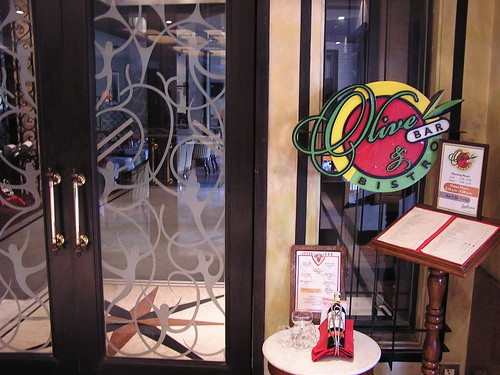
They offered steaks (something you can't always find in Nepal or India), including chateaubriand, rib-eye, filet mignon, etc. It was fairly tasty, too. If you really wanted, though, you could order a Nepali thali--a Nepalese meal with an assortment of dishes, either vegetarian or non-vegetarian. The non-veg consisted of rice, naan, roti, gulab jamun (pronounced almost like glab zamn), lamb rogan josh, chicken in a creamy yoghurt, paneer in a sweet tomato sauce (I think it might have been paneer khadai), dhaal, and fried saag. There was a side of raita which we were told you can eat with things or, as our server likes it, straight. That was definitely one of my best meals.
This was much better than my first lunch, where I ate a whole chili--yikes! I thought it was a peapod, at first, based on the color and, frankly, the fact it was by itself (who would take chilies to eat them whole? I guess some people...).
I was warned not to drink the water, but the hotel gives out complimentary bottled water in the rooms.

The Radisson is nice--I would definitely stay there again. There are a lot of backpackers here--especially tour groups. You can see them getting ready to get on their buses--everyone has the exact same colored luggage--I'm guessing most of it is equipment provided by the tour company or some such. It is also close to the Royal palace and the Thamel district, where most of the tourists hang out.

Thamel is quite the happening place at night--and apparently all day, though I'll get to that later. Watch your wallet--make sure you have taken precautions because there are pickpockets about. Also, Nepalese do bargain--I know I ended up buying two hats that were at least twice what I was quoted at the next stall over! Oh well, live and learn. In the end, bargaining comes down to finding a price that you and the seller think is fair--beyond that, it shouldn't matter. Caveat emptor, however--it is really up to you to decide the provenance of any given item as the seller may or may not give you the real information. Oh, and I have to wonder if some of the shops are 'authorized' vendors:
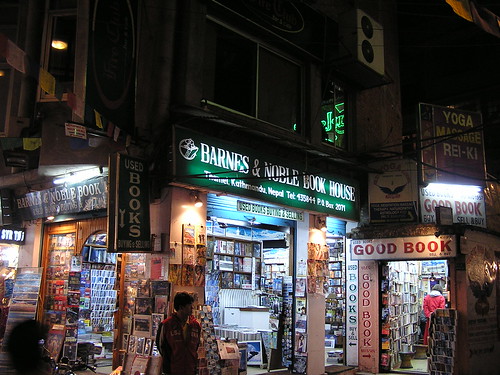
Friday morning I went back to Thamel. I already knew it was going to be interesting; you see Friday was the Holi festival in Nepal--the festival of colors. Celebrated in most Indo-Asian nations in one form or another, some of the largest features are: 1) Throwing water, and 2) colors. These often combine in the tradition of throwing colored water.
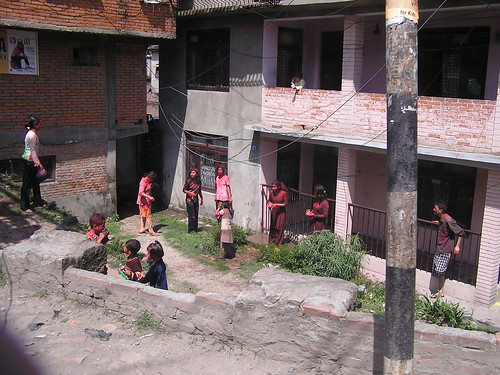
Somehow I missed getting any of the colored water on me--though I did get splashed with a few regular water balloons. Here they are small, plastic bags that are filled and tied off. People especially like to throw them from the upper stories of multi-storied buildings. The height of Holi day is apparently after 11am, when things really kick into gear.
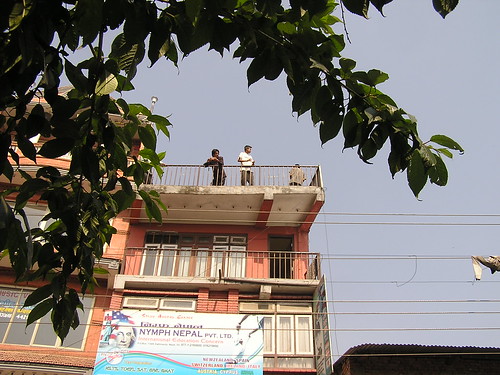
Fortunately, things were pretty quiet early in the day--I went down to Thamel to look around and there wasn't much going on yet. First I came through the main entrance, past a pagoda/bank on the right side of the road:
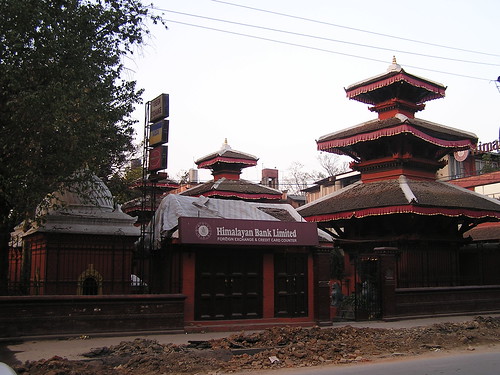
I got up around 5:40 in the morning and was out of the hotel just a little after 6am. The tourist district, centered on 'Thamel', was pretty sleepy in the early hours, so I did a lot of walking, taking pictures of the architecture, shrines, and daily life.

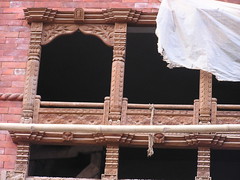



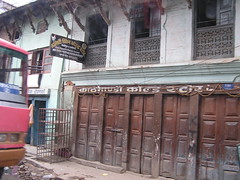
The buildings here are quite amazing. I took a lot of pictures so you can see what I mean. Some of them almost look ready to fall apart, yet there are details such as the wood carvings that are exquisite. Wood is quite prevalent in their construction, and I noticed that it was common for there to be wooden ladders, rather than stairs, connecting the floors. Many doors were also below street level, with a very small entrance that you have to duck into. Store fronts aren't large, open fronts, but rather multiple doors that are all opened up. All sorts of businesses have this same structure.
Sacred spaces were omnipresent. From temples:

To large shrines:

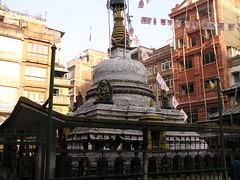
And small shrines:




Trees:

And even what appears to be a hole in a set of stairs:
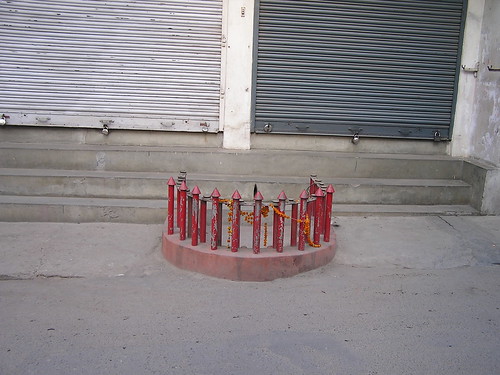
(Not sure about the last one, but it makes a good story...)
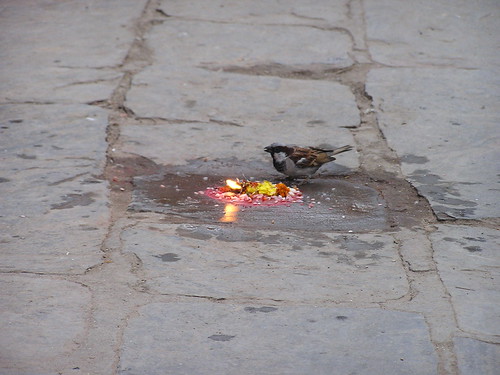
Apparently a lot of people make offerings of a sort just outside their doors--I'm not sure if this was because it was Holi or not, but I had been seeing the after effects and finally found one in progress.
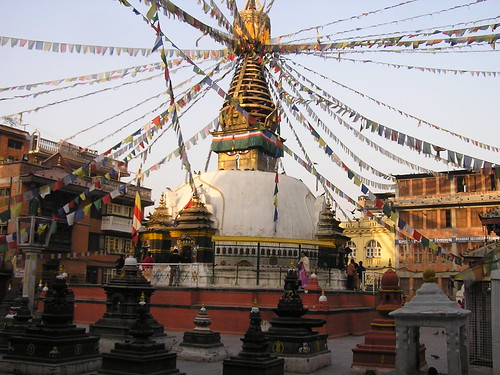
I eventually came upon a large temple area called Kathe Simbu, at least according to my maps. It was pretty impressive--a large square with many small shrines and a large stupa. There were several temples around the complex with monks chanting and performing rituals with fellow religionists. Around the stupa you can see a common item--prayer wheels. Inside each prayer wheel is a copy of a mantra, prayer, etc., which is also printed around the outside. Each turn of the wheel is as though you had said the mantra, thus increasing merit.

Another common practice is to put some paint or dye on the image of a deity as a kind of offering. Red is a common color, usually placed upon the head, though sometimes (as you can see above) it is used all over. I have heard that Ganesha, in particular, is fond of red, but I don't fully know its significance otherwise.
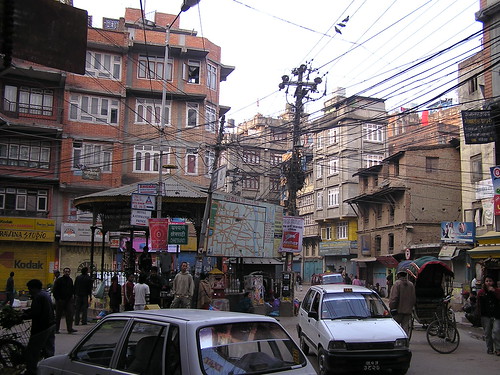
Walking down the street, I felt somewhat out of place, but not overly threatened, even in the relatively abandoned side-streets I occasionally walked down. I was on the lookout for water balloons--though one did catch me by surprise. I had on a jacket for the occasion, though, and a change of clothes waiting back at the hotel. I did get accosted a few times by people who were trying to sell something and would keep after me for a block or more.
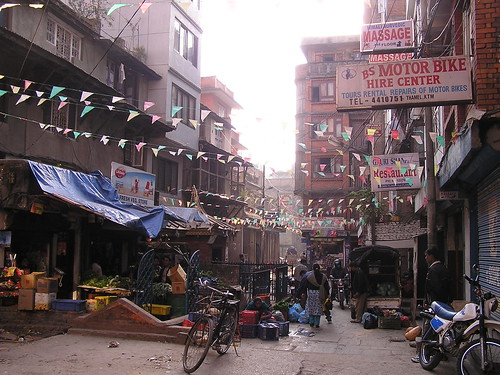
As more people showed up, you started seeing more people with the water balloons. At one point I heard a commotion and turned around. I saw another tourist running around a corner towards me, and soon a parade of men, all of them doused in red dye, came after him, turning up the street away from us. I decided that my best course of action was to move from store to store, in case a large group of colored water-throwers happened through. They never did, though.
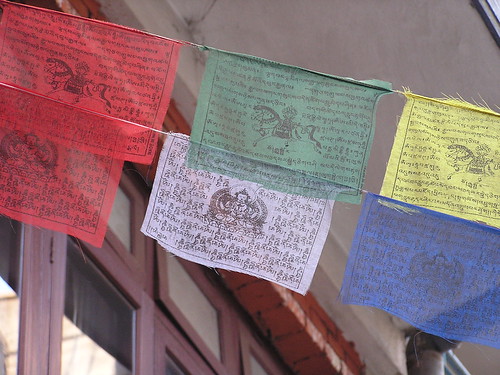
Kathmandu is an interesting place. Religious icons are everywhere, and despite all the issues (Maoists, Tibet, and a lack of fuel which must be imported from India) I did not feel any oppressive sense of doom. Holi day, especially, was a time when complete strangers were laughing with one another and enjoying themselves. Smiles were everywhere, even in horrible conditions, proving the resiliency of the human spirit. I believe it was Anthony Bourdain who pointed out the symbolism of my penultimate photo. Something that I believe encompasses a human ideal found throughout the world that keeps all of us going, whatever reasons we may have to quit: Hope. Here we have the class third-world icon; a building, occupied and in business, with girders sticking out of the roof. It is as if it is saying, "I may have only one floor today, but one day..." It expresses, for me, a feeling that the owners have not given up, but are looking forward to better times. That is a powerful message.

But if that's my penultimate photo then what, might you ask, is the ultimate? A monkey of course!
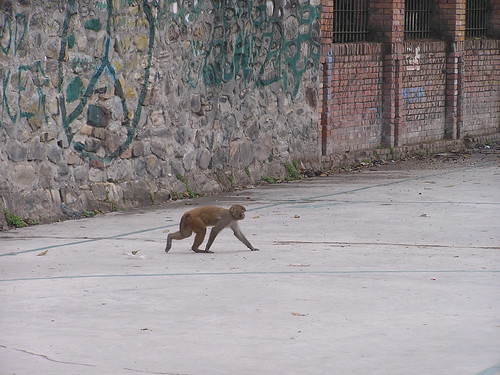
And that concludes my slideshow. Thank you for reading. (And now you see why I don't post much--this has taken up way too much of my time and yours)
